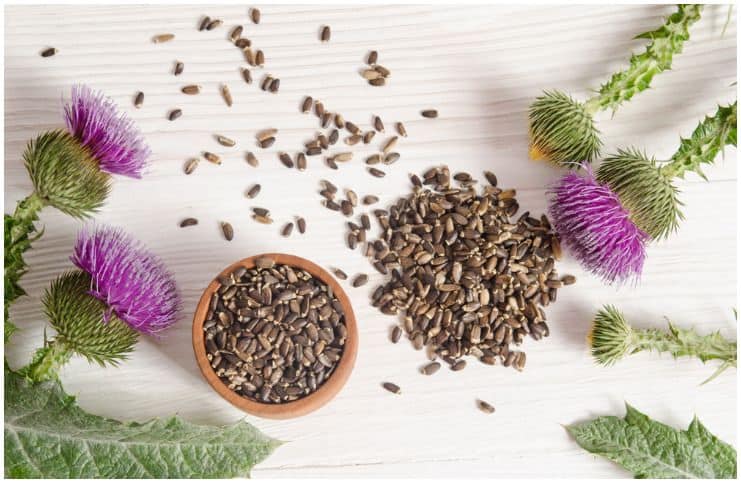Milk Thistle Seed (Silybum Marianum) – Side Effects, Facts, Uses, Health Benefits:
Facts
Milk thistle is a herb that comes from the same group of flowers as the daisy – Asteraceae family. It is also called the Marian thistle, holy thistle, Mary thistle, Our Lady’s thistle, St. Mary thistle, wild artichoke, Chardon-Marie (French), and Mariendistel (German).
It is native to southern Russia and southern Europe, and it contains a complex of therapeutic compounds known collectively as silymarin.
It has actually been used for over 2,000 years.
The Greek physician and botanist Dioscorides was the first to describe the holy thistle’s healing properties back in the year 40 A.D. In the 19th and 20th centuries, many physicians in the U.S. prescribed this herb for liver, spleen, and kidney disorders and for pelvic congestion and varicose veins.
Silymarin – the active component
The seeds of this plant contain the highest concentrations of the active compound, silymarin. It is an antioxidant that reduces oxidative damage and free radical production. It may also inhibit the binding of toxins to the liver.
In animals, this antioxidant reduces liver injury caused by acetaminophen (or paracetamol) and has been shown to have positive effects on hepatitis, alcoholic liver disease, and toxin-induced liver problems.
Uses and Health Benefits of Silybum Marianum
Helps protect against cancer
Although more studies on Mary thistle’s effects on cancer are still in the early stages, it appears that this plant extract can have an inhibitory effect on the expansion of cancer cells and tumors on the skin and can also help prevent cancerous growth in the breast, prostate, and cervix. Given the mortality rates of those particular types of cancer, Silybum Marianum extract may be a major herbal advantage.
Liver detoxification and health
According to research, this plant acts as a natural liver supporter and detoxifier.
The liver constantly works hard to help defend us from toxins that are regular in our everyday lives, acting as a filter and removing harmful substances from the body.
The liver helps remove harmful substances from our blood, detoxifies the body, aids in hormone production, releases glucose into the bloodstream in order to give our body constant energy, and releases bile into our small bowel so fat can be absorbed from foods. You can see why an inadequate liver function can create so many problems!
Type 2 diabetes mellitus
Silymarin, an extract from this plant, contains potent antioxidant compounds, which are known to be beneficial in treating diabetes. This antioxidant reduces blood sugar levels, defends insulin-producing β-cells in the pancreas and helps patients with diabetes in a variety of other ways.
In one study, 200 mg 3 times a day significantly reduced fasting blood glucose in people with type 2 diabetes, lowered bad cholesterol (LDL), and triglycerides in this group. Identical results have been found in other studies. It also can help prevent complications of diabetes.
It helps maintain a healthy heart
Extract from this plant contains high concentrations of beneficial fatty acids and omega-3, which are important for maintaining the good health of the heart.
Omega-3 acids are able to balance cholesterol levels in your body, preventing atherosclerosis, hence lowering your risk of experiencing a heart attack or a stroke.
Psoriasis
Because the liver neutralizes certain toxins (like hormone enhancers, medications, drugs, food additives, preservatives, artificial sweeteners, flavor enhancers, alcohols, chemicals used in agriculture, fumes, volatile organic compounds, air pollution, and many other factors) associated with psoriasis attacks, this plant is believed to help prevent psoriasis outbreaks by promoting normal liver function.
Several other dermatological uses for this herb are currently under investigation. The antioxidant properties of this amazing herb may have a healing effect on skin wounds and burns.
Also, it has been proposed as a cosmetic agent to preserve skin tone and quality. Further research is needed to prove the efficacy of the herb for these applications.
HIV natural treatment
It is sometimes prescribed for HIV-positive patients to protect the liver from diseases, like hepatitis and from the hepatotoxic effects (or chemical-driven liver damage) of other medications prescribed for HIV treatment.
How to use it
It is typically taken in capsules or tablets, as a tincture or liquid extract. It can also be eaten fresh – simply add the leaves to your stir-fry or grind the seeds into cereal.
Side Effects of Milk Thistle
It may cause mild nausea and diarrhea, or loose stools. The plant may also cause an allergic reaction in some individuals, especially those with known allergies to plants in the Asteraceae family (thistles, artichokes, daisies).
No other widely reported side effects are known when this plant is taken in proper therapeutic dosages. However, people with chronic medical conditions should seek medical advice from their healthcare specialist before taking the herb.
READ THIS NEXT:
Thunder God Vine (Tripterygium Wilfordii) – Facts


